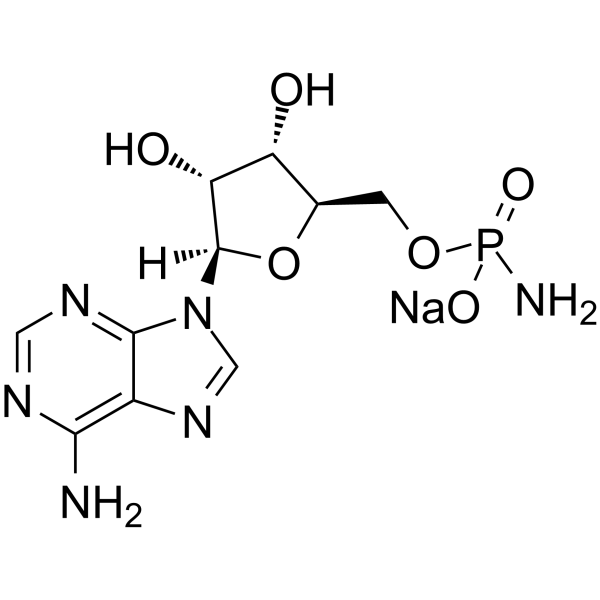Physicochemical Properties
| Molecular Formula | C10H14N6NAO6P |
| Molecular Weight | 368.22 |
| Exact Mass | 368.061 |
| CAS # | 102029-68-5 |
| PubChem CID | 23679049 |
| Appearance | White to off-white solid powder |
| Hydrogen Bond Donor Count | 4 |
| Hydrogen Bond Acceptor Count | 11 |
| Rotatable Bond Count | 4 |
| Heavy Atom Count | 24 |
| Complexity | 493 |
| Defined Atom Stereocenter Count | 4 |
| SMILES | C1=NC(=C2C(=N1)N(C=N2)[C@H]3[C@@H]([C@@H]([C@H](O3)COP(=O)(N)[O-])O)O)N.[Na+] |
| InChi Key | ALRHXZAMLVPXPL-MCDZGGTQSA-M |
| InChi Code | InChI=1S/C10H15N6O6P.Na/c11-8-5-9(14-2-13-8)16(3-15-5)10-7(18)6(17)4(22-10)1-21-23(12,19)20;/h2-4,6-7,10,17-18H,1H2,(H2,11,13,14)(H3,12,19,20);/q;+1/p-1/t4-,6-,7-,10-;/m1./s1 |
| Chemical Name | sodium;amino-[[(2R,3S,4R,5R)-5-(6-aminopurin-9-yl)-3,4-dihydroxyoxolan-2-yl]methoxy]phosphinate |
| HS Tariff Code | 2934.99.9001 |
| Storage |
Powder-20°C 3 years 4°C 2 years In solvent -80°C 6 months -20°C 1 month Note: Please store this product in a sealed and protected environment (e.g. under nitrogen), avoid exposure to moisture. |
| Shipping Condition | Room temperature (This product is stable at ambient temperature for a few days during ordinary shipping and time spent in Customs) |
Biological Activity
| References |
[1]. Adenosine and Adenine Nucleotides Stimulation of Skin (Epidermal) Adenylate Cyclase. Biochim Biophys Acta. 1976 Oct 22;444(3):685-93. |
Solubility Data
| Solubility (In Vitro) | DMSO : ≥ 25 mg/mL (67.89 mM) |
| Solubility (In Vivo) |
Solubility in Formulation 1: ≥ 2.5 mg/mL (6.79 mM) (saturation unknown) in 10% DMSO + 40% PEG300 + 5% Tween80 + 45% Saline (add these co-solvents sequentially from left to right, and one by one), clear solution. For example, if 1 mL of working solution is to be prepared, you can add 100 μL of 25.0 mg/mL clear DMSO stock solution to 400 μL PEG300 and mix evenly; then add 50 μL Tween-80 to the above solution and mix evenly; then add 450 μL normal saline to adjust the volume to 1 mL. Preparation of saline: Dissolve 0.9 g of sodium chloride in 100 mL ddH₂ O to obtain a clear solution. Solubility in Formulation 2: ≥ 2.5 mg/mL (6.79 mM) (saturation unknown) in 10% DMSO + 90% (20% SBE-β-CD in Saline) (add these co-solvents sequentially from left to right, and one by one), clear solution. For example, if 1 mL of working solution is to be prepared, you can add 100 μL of 25.0 mg/mL clear DMSO stock solution to 900 μL of 20% SBE-β-CD physiological saline solution and mix evenly. Preparation of 20% SBE-β-CD in Saline (4°C,1 week): Dissolve 2 g SBE-β-CD in 10 mL saline to obtain a clear solution. Solubility in Formulation 3: ≥ 2.5 mg/mL (6.79 mM) (saturation unknown) in 10% DMSO + 90% Corn Oil (add these co-solvents sequentially from left to right, and one by one), clear solution. For example, if 1 mL of working solution is to be prepared, you can add 100 μL of 25.0 mg/mL clear DMSO stock solution to 900 μL of corn oil and mix evenly. (Please use freshly prepared in vivo formulations for optimal results.) |
| Preparing Stock Solutions | 1 mg | 5 mg | 10 mg | |
| 1 mM | 2.7158 mL | 13.5788 mL | 27.1577 mL | |
| 5 mM | 0.5432 mL | 2.7158 mL | 5.4315 mL | |
| 10 mM | 0.2716 mL | 1.3579 mL | 2.7158 mL |
